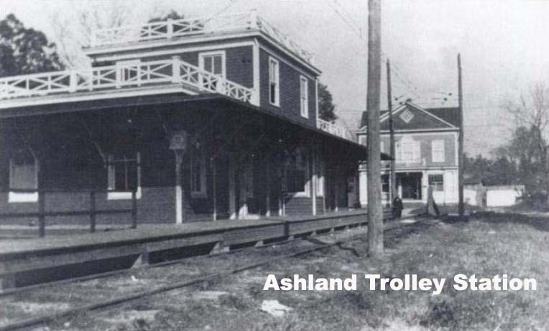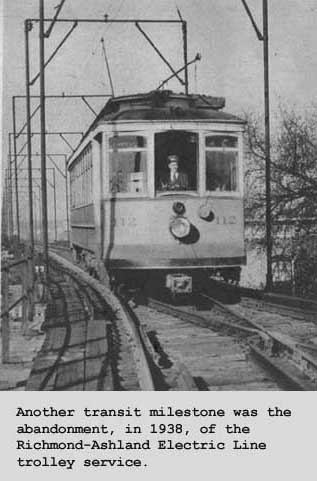In 1905, New York financierFrank Jay Gould established the
Richmond and Chesapeake Bay Railway. He had a vision for a high
speed electric railroad, which would run from Norfolk up to
Petersburg, Richmond, and Fredericksburg with branches to the
Northern Neck. This would allow much easier transportation of
summer produce and seafood from the Tidewater area to Richmond,
instead of to the port at Baltimore. A few years before, Gould had
purchased the Brook Turnpike, which was chartered in 1812 and
originally the only road leading north out of Richmond. In the
1830s, it took a 38 hour trip by stagecoach along the turnpike to
travel from Richmond to Washington. In 1834, the Richmond,
Fredericksburg and Potomac Railroad was chartered by the General
Assembly. The railroad’s charter included a unique statute
that prohibited any other railroads from being constructed anywhere
between Richmond and Washington. Gould was initially denied a
charter for his new railway based on this statue, but later granted
the charter after a Virginia Supreme Court decision. The first and
only part of the railway to be built, at a cost of $994,000, was
the 14.8 mile section from Richmond to Ashland. The trolley
officially began running on October 28, 1907.
The railway was very unique and innovative for its time. Instead
of traditional trolley cars, Gould wanted large, comfortable luxury
cars. The railway line used four 39 ton, 55 foot cars, which were
manufactured by the St. Louis car company. These were similar to
Pullman parlor cars with mahogany paneling, high-backed seats and
frescoed ceilings. They were dark green and cream colored with gold
trim. A 1908 schedule advertises “Cool – clean –
comfortable electric trains. No smoke. No cinders. Elegant cars.
Rock ballasted track.” Power for the trolley came to the
Richmond Depot through an underground cable from a hydroelectric
plant on 12th Street. The cars were designed so that they would
only absorb the power needed to run the trolley and return the rest
to the overhead wire. The leftover power in the line was used to
provide electricity to the town of Ashland. The cars used 6,600
volts of electricity at 25 cycles per second, which was much higher
than the 600 volts of direct current typically used by trolleys. At
that time, it was the only interurban railway using more than 3,300
volts. Because of the high voltage, a special wooden insulator was
designed for the place where the Ashland – Richmond line
crossed the lower voltage Lakeside streetcar line. To keep the
railway straight and level, it was necessary to construct a half
mile long bridge across several streets, another railway line, and
the Bacon’s Quarter Branch of Shockoe Creek. Gould planned to
build the bridge of wood, but changed his plans when he saw a
concrete viaduct while traveling in France. At the time of its
construction, the concrete viaduct for the Richmond – Ashland
trolley line was the largest in the United States. The trolley
began at the Richmond Depot on West Broad Street and Laurel Street
and ran north across Bacon’s Branch Ravine, and then north on
Brook Road past Laburnum. It ended at the white and mustard-colored
trolley station at the corner of Maple and England Streets in
Ashland, where the Post Office now stands.

After the Richmond - Ashland section was completed, the plan was
to begin building the line to Tappahannock, but this was never
completed, due to a stock market scare in October 1907 and possible
financial difficulties. The railway line remained open until
December 1917, but was never very profitable. It was put up for
auction and eventually purchased by Oliver J. Sands and Jonathan
Bryan in 1919 for $135,000 and chartered as the Richmond –
Ashland Railway. Instead of the 6,600 volt current, the line was
converted to the cheaper 600 volt current, and more traditional
trolleys were purchased second hand. Despite the efforts to revive
it, the Ashland – Richmond trolley continued to encounter
financial challenges and by 1936, the company’s deficit was
over $171,000. On March 22, 1938, the last trolley departed Ashland
at 11:10 pm, filled with nostalgic passengers, who took souvenirs
from the station in Richmond. On the way back, the whistle blew
continuously, waking nearby residents, and passengers sang
“Auld Lang Syne.” The copper wire and 2,800 tons of
rail were sold for $35,000. The railroad’s right of way was
purchased by Virginia Electric and Power Company to run electric
transmission lines.
The electric trolley holds many fond memories for local
residents. Dorothy Jones remembered hearing the story of her
parents wedding in 1911, when the whole wedding party rode the
trolley from Ashland to Richmond, amidst much fanfare and ringing
bells. Others remember attorney Rosewell Page riding the trolley.
When they crossed the Chickahominy River on the way back to
Ashland, he would rise, take off his hat and shout, “All
stand! We are in Hanover County, God bless her!” Another
Ashlander remembered riding the trolley when she was very young,
and how terrified she was of the high bridge. Her family’s
cook, who rode with her, would distract her by telling her to look
down at the chimneys to see Santa Claus. A Richmonder remembers
riding the trolley to visit a college in Ashland when he was
fourteen, and how long the trip seemed to him.

Today, a half mile section of the old Richmond – Ashland
Trolley line has been dedicated as greenway to preserve this unique
and interesting part of our local history. The Ashland Trolley Line
Park trail is an easy 0.5 mile walk (1 mile round trip) along a
very straight & level path. The Richmond Audubon Society has a
checklist of 76 different species of birds that have been seen on
this trail. You can see the check list
here. Enjoy the history, the birds, and your walk.
Sources:
“ Rails in Richmond” by Carlton Norris McKenney (This
is a great place to start if you’d like more information and
pictures of the trolley. The book is about streetcars in Richmond,
and there’s a whole chapter on the Richmond – Ashland
trolley line. The Hanover and Ashland branches of Pamunkey Library
have copies of the book.)
“Ashland, Ashland: The Story of a Turn of the Century
Railroad Town” by Rosanne Groat Shalf
Richmond
- The Alumni Magazine
Laburnum
Park Historic District
National Register of Historical Places
Richmond Then & Now
Historic
Richmond (A Look at the Richmond of Yesterday)
Ashland By Pale Paige Talley